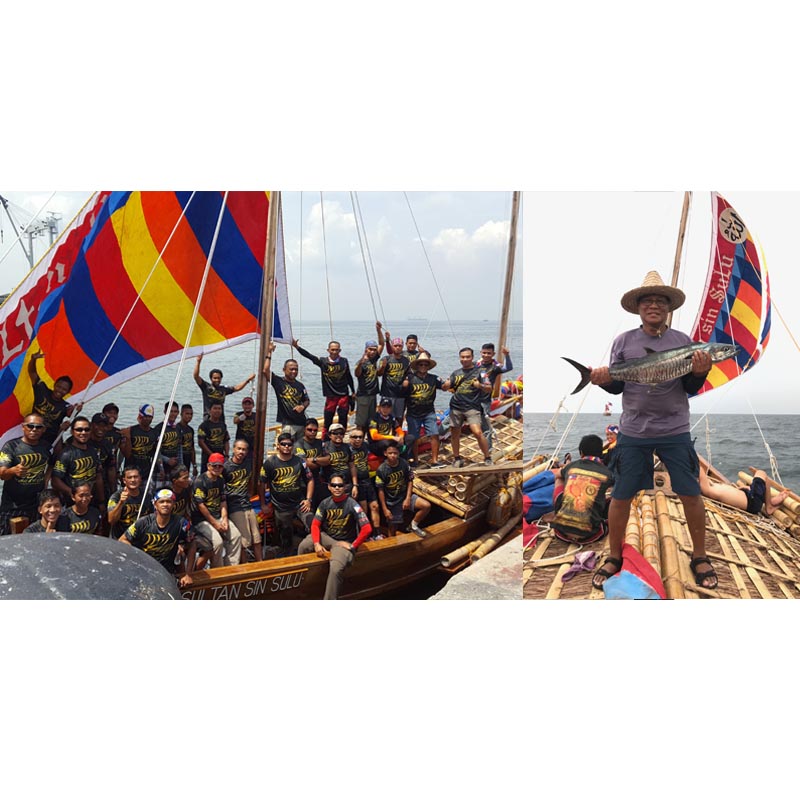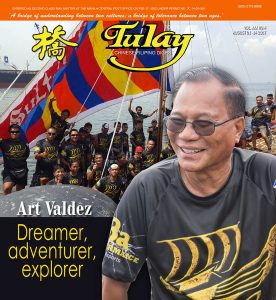
Not too many know Arturo “Art” Valdez, but they should. He organized the first all-Filipino team that climbed Mount Everest and then sailed around the Philippines and Southeast Asia in a reconstructed ancient balangay. He’s planning to take the same balangays to China on a voyage similar to that undertaken by Sultan Paduka Batara 600 years ago.
So, who is this dreamer-adventurer-explorer named Art Valdez?
Born on Oct. 10, 1948 in Bacolod, Valdez’s parents are from Negros, a farmer and a teacher. In his teens, he became a boy scout and developed a great love for the outdoors. He climbed his first mountain, Mount Kanlaon in Negros, at 16.
Valdez spent a year in the United States as an exchange student during the mid-1960s. On his return home in 1966, he participated in student demonstrations to help change the injustices and inequality in Philippine society.
He joined the radical student group Kabataang Makabayan, neglecting his studies on his last year of Economics major at the University of Santo Tomas. But much to his surprise, the university had allowed him to graduate with a grade of 75.
In 1971, Valdez was chosen to study at the Konrad Adenauer Foundation in Germany. He spent a year there studying about the social market economy.
When he came back in 1972, his brother advised him to get an MBA, but he decided instead to study at the University of Life – not the one Imelda Marcos founded but rather learning life experience directly.
He went back to student activism, in charge of recruiting student leaders in the Visayas and Mindanao. At Siliman University, he met Luzviminda Santos. They fell in love and got married in 1973.
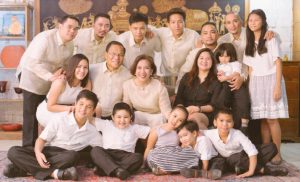
They were a good match, but she channeled her talent and energy into politics instead and served three terms as mayor of Bacolod. They have four children – three sons (Alexis, Dennis and Arturo Jr.) and a daughter (Tamara Joy).
In recent years, the family grew as Valdez and his wife adopted three more children – Vincent, a mestizo Tsinoy baby left at a radio station; Ang Pasang, a Sherpa boy that Valdez brought home from Nepal; and Daisy, a Badjao girl.
Early on, Valdez demonstrated his talent for organizing and getting things done. He turned a near-bankrupt trucking company in Negros around, and brought in 1,500 sakadas from Negros to harvest sugar cane in Cagayan Valley before the rainy season set in, which would have ruined the crops.
Bal Lumayno, of the Philippine Sugar Commission, said of Valdez: “When it comes to problem solving, Art has this do or die attitude. If there is a problem, he will not sleep until he is able to find a solution.”
He is also able to find the best people for the job. “It doesn’t matter to Art what kind of background the person has or what he has done. What is more important to Art as to what can this person can do and if he is willing to see the project through from start to finish.”
But Valdez wasn’t quite done with activism. He admits that between 1973 and 1980, he was arrested four times and spent total time in jail of at least two years. But he says his politics have since shifted, and he now describes himself as a Christian Democrat as espoused by the late senator Raul Manglapus.
Valdez’ talent as a leader and manager caught the eye of then president Fidel Ramos, who appointed him undersecretary at the Department of Transportation and Communication in 1996. He stayed with the DOTC until 2004. In 2007, he was deployed to the Middle East as a special envoy, staying there for a year.
He is currently still in government as undersecretary for field operations at the Department of Environment and Natural Resources. He is also a director at the Lopez-owned Energy Development Corp., the country’s pioneer in geothermal energy generation.
While Valdez was busy building his career and raising a family, his thirst for adventure never waned. He served as president for the National Mountaineering Federation of the Philippines from 1974 to 1996.
In 1982, he considered organizing the first all-Filipino climb of Mount Everest, but the project never got beyond the planning stage.
In 2003, Valdez decided it was time and publicly announced the first all-Filipino expedition to Mount Everest. His goal: to inspire and unify the nation with this historic climb. He recruited top local mountaineers Leo Oracion, Erwin Emata and Carina Dayondon.
He also recruited support team members such Ted Esquerra, the only doctor in the Philippines who specialized in high altitude sickness. He secured sponsorship from businessman Oscar Lopez, in exchange for giving the latter’s television network ABS-CBN rights to cover the project.
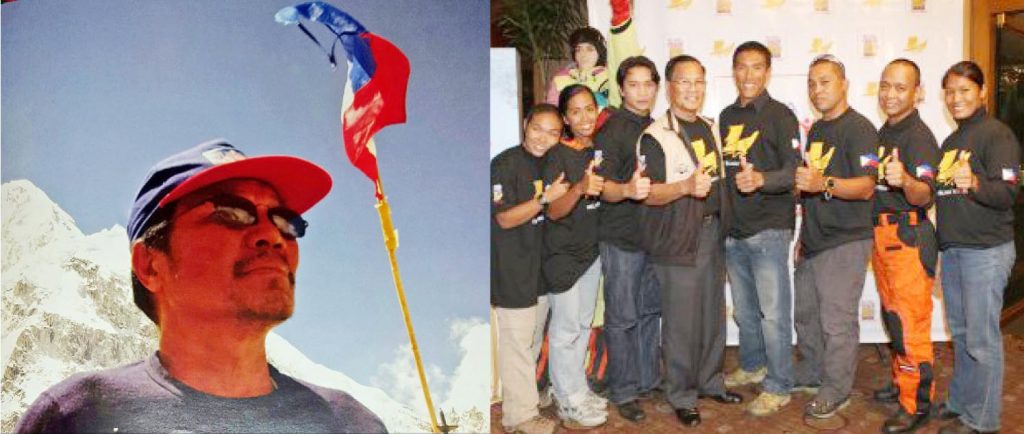
It took the team three years to prepare themselves physically and mentally. Things also did not go as planned. One of the mountaineers that Valdez tried to recruit, Romeo Garduce, decided to form his own Mount Everest expedition team and got funding from rival TV network GMA.
A third Filipino climber, Dale Abenojar, also announced that he was going to climb Everest. They all finally made the climb in May 2006. So, who reached the summit first?
The Himalayan Database, which documents every successful attempt to reach the summit of Mount Everest, credits Abenojar as the first one to reach the summit from the Tibetan side on May 15.
Oracion left his team mate and climbed on his own on May 13, reaching the summit four days later. His team mate Erwin Emata followed the day after and then one day after him it was Garduce.
Valdez does not agree with the record and still insists today it was Oracion who was the first Filipino to climb Mount Everest.
But a bigger disappointment for Valdez is that what could have been a chance to unify the country became just another episode that highlighted our disunity. But the experience taught him valuable lessons. “One is that the belief in one’s self and in one’s team is important. Another is that teamwork and unity are key ingredients for success.”
In the end, he chooses to view the whole episode in a positive light. “We all climbed the summit, we all came back safe and that is what is important.”
Valdez next organized a three-woman climbing team comprised of Carina Dayondon, Noelle Wenceslao and Janet Belarmino. Since they were in the right physical condition, he scheduled the climb immediately in the following year 2007.
Unlike their first attempt to scale Everest from the south side, this time he chose a route from the north crossing over from Tibet. Not only that, this time the team would not only climb the mountain, but transverse it as well.
The ladies worked as a team and were able to accomplish what the men failed to do. “To date we have the first and only crossing of Everest by women. It is a record that is unbroken even ‘til today,” he says.
That wasn’t the end of his engagement with Everest. In 2008, Valdez himself ran the 42-K Everest Marathon, finishing in 10 hours, five minutes and 46 seconds. It was only after the marathon that he began thinking of what he was going to do next.
“I was thinking of crossing the Sahara Desert, but deserts are not in our consciousness. What about a boat and tracing the voyage of our Austronesian forefathers? We could build a balangay which our forefathers sailed with over the vast Pacific and Indian Oceans,” he says.
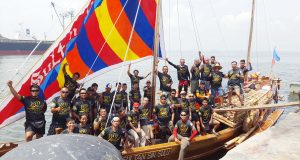 To reconstruct the boats, Valdez and his team hired boat builders from the Sama Dilaya tribe from Sibutu and Sitangkai islands of Tawi-Tawi. The first boat was built in Manila on the grounds of the CCP Complex.
To reconstruct the boats, Valdez and his team hired boat builders from the Sama Dilaya tribe from Sibutu and Sitangkai islands of Tawi-Tawi. The first boat was built in Manila on the grounds of the CCP Complex.
It would later be given the name of Diwata ng Lahi.
As the boat was being constructed, Valdez began recruiting the crew that will man the boats. Aside from members of the Everest expedition, he included the Sama boat builders and sailors. Valdez also recruited experienced personnel from the Navy and the Coast Guard.
The Diwata was ready by the end of June 2009, but he decided not to sail yet as he was waiting for the amihan or the northeasterly winds to power their journey south to Mindanao. After much consideration, they chose Sept. 1, 2009 as the starting date of their journey.
On the morning of the appointed day, a departure ceremony for Diwata and her crew was held at Manila Bay near the Folk Arts Theater. However, when Diwata sailed toward the mouth of the bay, she was greeted by high waves whipped up by the approach of Typhoon Labuyo.
Unsure of the capability of Diwata, the crew waited out the storm at the mouth of the Ternate River in Cavite. On the fourth day, flood water was released from the Maragodon Dam. The powerful rush of water from the river pushed Diwata out to the sea, where they were met with high waves.
But the crew’s fear and anxiety gave way to courage and hope when Diwata, instead of sinking, bravely sailed through the waves. Even the Sama boat builders were in disbelief at how the Diwata survived her baptism of fire.
Diwata was eventually joined by two other boats on her maiden voyage – Masawa Hong Butuan and Sama Tawi Tawi. As they sailed around the Philippines and Southeast Asia, they were faced with challenges.
In Boracay, Sama Tawi Tawi’s hull was pierced when it hit a submerged coral. Several times, the crew was nearly kidnapped by armed men in the southern part of the Philippines. But there were also times when the pirates avoided them, as the crew looked like pirates themselves. Numerous times they were held by naval authorities from Malaysia, Cambodia and Indonesia.
But all these difficulties were made up for by the beauty they encountered on their voyage. Dolphins swam alongside the boats. Spirits were lifted by the welcome they received when they landed. Hunger and fatigue would disappear when they saw the enthusiasm of school children wanting to learn more about the country’s maritime heritage.
By December 2010, the voyage of the balangay was about to come to an end. Valdez invited all former and current presidents to join them on the final leg of the journey from Cavite to the CCP. The message he wanted to send was that despite our leaders’ differences, they must never at any point endanger the country itself, but rather learn to work together and safely guide the country to the right port at the destination.
Former president Ramos agreed to join the final leg of the journey. Then newly elected President Benigno Aquino III sent executive secretary Paquito Ochoa Jr. as his representative. On Dec. 13, the three vessels sailed into the breakwater behind the Manila Yacht Club and were greeted by a grand homecoming ceremony.
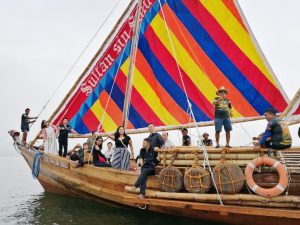
At present, two of the boats are on public display. Diwata ng Lahi can now be seen at the back of the National Gallery of Art at the National Museum. The Masawa Hong Butuan is in a special pavilion in Butuan City. Since Valdez and his team are planning more sea voyages, they have commissioned two more boats, the Sultan Sin Sulu and Lahi ng Maharlika.
The team aims for China as the next destination, to commemorate the 600 year anniversary of Sultan Paduka Batara’s journey from his kingdom in Sulu to China.
The trip was supposed to coincide with President Duterte’s China visit last May. But because of inclement weather, as well as repair and maintenance issues, the trip has been tentatively postponed to April next year.
Now nearing his 70s, Valdez doesn’t seem to be slowing down. Having sailed twice with him on the Sultan Sin Sama, I can attest that he was just as energetic and nimble as the younger sailors. So Valdez continues to spread his message, a call for national unity and to develop our maritime domain.
